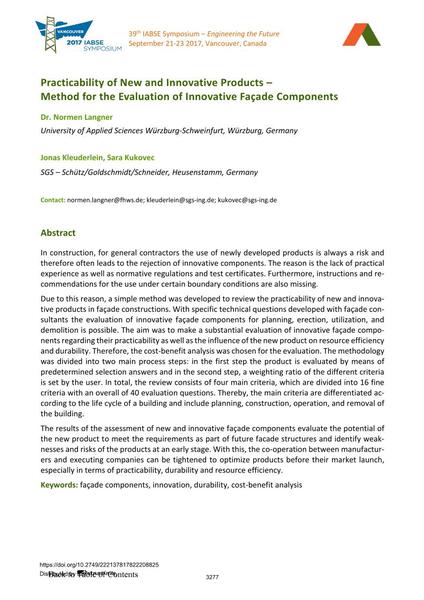Practicability of New and Innovative Products –

|
|
|||||||||||
Bibliografische Angaben
| Autor(en): |
Normen Langner
(University of Applied Sciences Würzburg-Schweinfurt, Würzburg, Germany)
Jonas Kleuderlein (SGS – Schütz/Goldschmidt/Schneider, Heusenstamm, Germany) Sara Kukovec (SGS – Schütz/Goldschmidt/Schneider, Heusenstamm, Germany) |
||||
|---|---|---|---|---|---|
| Medium: | Tagungsbeitrag | ||||
| Sprache(n): | Englisch | ||||
| Tagung: | IABSE Symposium: Engineering the Future, Vancouver, Canada, 21-23 September 2017 | ||||
| Veröffentlicht in: | IABSE Symposium Vancouver 2017 | ||||
|
|||||
| Seite(n): | 3277-3282 | ||||
| Anzahl der Seiten (im PDF): | 6 | ||||
| Jahr: | 2017 | ||||
| DOI: | 10.2749/222137817822208825 | ||||
| Abstrakt: |
In construction, for general contractors the use of newly developed products is always a risk and therefore often leads to the rejection of innovative components. The reason is the lack of practical experience as well as normative regulations and test certificates. Furthermore, instructions and re- commendations for the use under certain boundary conditions are also missing. Due to this reason, a simple method was developed to review the practicability of new and innova- tive products in façade constructions. With specific technical questions developed with façade con- sultants the evaluation of innovative façade components for planning, erection, utilization, and demolition is possible. The aim was to make a substantial evaluation of innovative façade compo- nents regarding their practicability as well as the influence of the new product on resource efficiency and durability. Therefore, the cost-benefit analysis was chosen for the evaluation. The methodology was divided into two main process steps: in the first step the product is evaluated by means of predetermined selection answers and in the second step, a weighting ratio of the different criteria is set by the user. In total, the review consists of four main criteria, which are divided into 16 fine criteria with an overall of 40 evaluation questions. Thereby, the main criteria are differentiated ac- cording to the life cycle of a building and include planning, construction, operation, and removal of the building. The results of the assessment of new and innovative façade components evaluate the potential of the new product to meet the requirements as part of future facade structures and identify weak- nesses and risks of the products at an early stage. With this, the co-operation between manufactur- ers and executing companies can be tightened to optimize products before their market launch, especially in terms of practicability, durability and resource efficiency. |
||||
| Stichwörter: |
Dauerhaftigkeit Kosten-Nutzen-Analyse Innovation
|
||||
